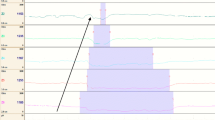Abstract
Gastroesophageal reflux disease (GERD) is a common disease in infants and children. Prolonged (24-hr) pH monitoring in the esophagus for determination of increased acid exposure has, together with endoscopy, been the only routinely implemented method for GERD diagnosis. The recently introduced multiple intraluminal impedance (MII) provides additional information about the number of both acid and nonacid episodes of retrograde bolus movement in the esophagus. The aim of this study was to investigate the day-to-day reproducibility and the interobserver variability of 24-hr combined MII (number of nonacid and acidic reflux episodes) and pH in the esophagus in infants and children. Upper endoscopy followed by 2 × 24-hr consecutive combined MII and pH monitoring was performed in 33 infants and children referred to a tertiary center for evaluation of GERD. The study was performed in a hospital setting without dietary restrictions. Bland-Altman difference versus mean plots and calculation of the limits of agreement (LOA) were used for assessment of the reproducibility of the total number of acidic and nonacidic reflux episodes. LOA for the number of acidic reflux episodes on day 2 were 0.2–5.3 times the value obtained on day 1. For the total number of nonacidic reflux episodes, LOA were 0.04–8.6; for the total number of reflux episodes, 0.3–3.3. An abnormal reflux index on one or both recording days was found in 7 of 30 patients. In conclusion, considerable day-to-day variability was found for nonacidic reflux episodes. Less variability was found for acidic reflux episodes. This variability must be taken into consideration for the use of MII in the clinical evaluation of infants and children with GERD.


Similar content being viewed by others
References
Vandenplas Y, Goyvaerts H, Helven R, Sacre L (1991) Gastroesophageal reflux, as measured by 24-hour pH monitoring, in 509 healthy infants screened for risk of sudden infant death syndrome. Pediatrics 88:834–840
Rudolph CD, Mazur LJ, Liptak GS, et al. (2001) Guidelines for evaluation and treatment of gastroesophageal reflux in infants and children: recommendations of the North American Society for Pediatric Gastroenterology and Nutrition. J Pediatr Gastroenterol Nutr 32(Suppl 2):S1–S31
Wenzl TG, Moroder C, Trachterna M, et al. (2002) Esophageal pH monitoring and impedance measurement: a comparison of two diagnostic tests for gastroesophageal reflux. J Pediatr Gastroenterol Nutr 34:519–523
Mitchell DJ, McClure BG, Tubman TR (2001) Simultaneous monitoring of gastric and oesophageal pH reveals limitations of conventional oesophageal pH monitoring in milk fed infants. Arch Dis Child 84:273–276
Skopnik H, Silny J, Heiber O, Schulz J, Rau G, Heimann G (1996) Gastroesophageal reflux in infants: evaluation of a new intraluminal impedance technique. J Pediatr Gastroenterol Nutr 23:591–598
Sifrim D, Silny J, Holloway RH, Janssens JJ (1999) Patterns of gas and liquid reflux during transient lower oesophageal sphincter relaxation: a study using intraluminal electrical impedance. Gut 44:47–54
Castell DO, Vela M (2001) Combined multichannel intraluminal impedance and pH-metry: an evolving technique to measure type and proximal extent of gastroesophageal reflux. Am J Med 111(Suppl 8A):157S–159S
Sifrim D, Holloway R, Silny J, et al. (2001) Acid, nonacid, and gas reflux in patients with gastroesophageal reflux disease during ambulatory 24-hour pH-impedance recordings. Gastroenterology 120:1588–1598
Sifrim D, Castell D, Dent J, Kahrilas PJ (2004) Gastro-oesophageal reflux monitoring: review and consensus report on detection and definitions of acid, non-acid, and gas reflux. Gut 53:1024–1031
Wenzl TG, Schenke S, Peschgens T, Silny J, Heimann G, Skopnik H (2001) Association of apnea and nonacid gastroesophageal reflux in infants: Investigations with the intraluminal impedance technique. Pediatr Pulmonol 31:144–149
Sifrim D, Dupont L, Blondeau K, Zhang X, Tack J, Janssens J (2005) Weakly acidic reflux in patients with chronic unexplained cough during 24 hour pressure, pH, and impedance monitoring. Gut 54:449–454
Zerbib F, des Varannes SB, Roman S, et al. (2005) Normal values and day-to-day variability of 24-h ambulatory oesophageal impedance/pH monitoring in a Belgian-French cohort of healthy subjects. Aliment Pharmacol Ther 22:1011–1021
Shay S, Tutuian R, Sifrim D, et al. (2004) Twenty-four hour ambulatory simultaneous impedance and pH monitoring: a multicenter report of normal values from 60 healthy volunteers. Am J Gastroenterol 99:1037–1043
Nielsen RG, Kruse-Andersen S, Husby S (2003) Low reproducibility of 2×24-hour continuous esophageal pH monitoring in infants and children: a limiting factor for interventional studies. Dig Dis Sci 48:1495–1502
Pandolfino JE, Richter JE, Ours T, Guardino JM, Chapman J, Kahrilas PJ (2003) Ambulatory esophageal pH monitoring using a wireless system. Am J Gastroenterol 98:740–749
Hochman JA, Favaloro-Sabatier J (2005) Tolerance and reliability of wireless pH monitoring in children. J Pediatr Gastroenterol Nutr 41:411–415
Bredenoord AJ, Weusten BL, Timmer R, Smout AJ (2005) Reproducibility of multichannel intraluminal electrical impedance monitoring of gastroesophageal reflux. Am J Gastroenterol 100:265–269
Peter CS, Sprodowski N, Ahlborn V, et al. (2004) Inter- and intraobserver agreement for gastroesophageal reflux detection in infants using multiple intraluminal impedance. Biol Neonate 85:11–14
Bland JM, Altman DG (1986) Statistical methods for assessing agreement between two methods of clinical measurement. Lancet 1:307–310
Lundell LR, Dent J, Bennett JR, et al. (1999) Endoscopic assessment of oesophagitis: clinical and functional correlates and further validation of the Los Angeles classification. Gut 45:172–180
Rosen R, Lord C, Nurko S (2006) The sensitivity of multichannel intraluminal impedance and the pH probe in the evaluation of gastroesophageal reflux in children. Clin Gastroenterol Hepatol 4:167–172
Author information
Authors and Affiliations
Corresponding author
Rights and permissions
About this article
Cite this article
Dalby, K., Nielsen, R.G., Markoew, S. et al. Reproducibility of 24-Hour Combined Multiple Intraluminal Impedance (MII) and pH Measurements in Infants and Children. Evaluation of a Diagnostic Procedure for Gastroesophageal Reflux Disease. Dig Dis Sci 52, 2159–2165 (2007). https://doi.org/10.1007/s10620-006-9731-y
Received:
Accepted:
Published:
Issue Date:
DOI: https://doi.org/10.1007/s10620-006-9731-y




